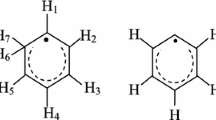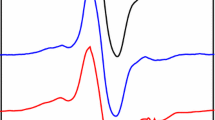Abstract
In the present work, spectroscopic, kinetic and dosimetric features of the radicalic intermediates produced after gamma irradiation at room temperature of solid triclosan (2,4,4-trichloro-2-hydroxydiphenyl ether; TCS) were investigated by means of electron spin resonance spectroscopy (ESR) at various temperatures. The same material was also irradiated with UV light, and an ESR spectrum very similar to that obtained for gamma-irradiated TCS, was recorded. The ESR spectrum of TCS is characterized by an unresolved doublet with resonance lines split into other doublets. An evaluation technique based on variations of four assigned peak-to-peak amplitudes and signal intensity was adopted, to monitor the evolution of the spectrum under different experimental conditions. Radicals of one type were proposed to be created upon irradiation exhibiting decays via intra-track and inter-track recombination reactions with activation energies of 43 ± 2 and 139 ± 6 kJ/mol, respectively. A radical exhibiting axial g anisotropy and interacting with two un-equivalent protons was found to describe the experimental spectrum well. The sensitivity of TCS to gamma radiation was high (G = 0.12) suggesting TCS to be a suitable dosimetric material in measuring normal and accidental radiation doses in the range of (1–25 kGy).










Similar content being viewed by others
References
Aranami K, Readman JW (2007) Photolytic degradation of triclosan in freshwater and seawater. Chemosphere 66(6):1052–1056
Basly JP, Longy I, Bernard M (1997a) Radiation sterilization of formoterol. Pharm Res 14(6):810–814
Basly JP, Longy I, Bernard M (1997b) Influence of radiation treatment on two antibacterial agents and four antiprotozoal agents: ESR study. Int J Pharm 154:109–113
Ferrer I, Mezcua M, Gómez MJ, Thurman EM, Agüera A, Fernández-Alba AR (2004) Liquid chromatography/time-of-flight mass spectrometric analyses for the elucidation of the photodegradation products of triclosan in wastewater samples. Rapid Commun Mass Spectrom 18:443–450
Fordyce P, Devries KL, Fanconi BM (2004) Chain scission and mechanical degradation of polystyrene. Polym Eng Sci 24(1):421–427
Gibella M, Crucq AS, Tilquin B, Stocker P, Lesgards G, Raffi J (2000) Electron spin resonance studies of some irradiated pharmaceuticals. Rad Phys Chem 58(1):69–76
Ikeya M (1993) New applications of electron spin resonance. Dating, dosimetry and microscopy. World Scientific, Singapore, pp 398–399
Kanetoshi A, Ogawa H, Katsura E, Kaneshima H, Miura T (1988) Formation of polychlorinateddibenzo-p-dioxin from 2,4,4′-trichloro-2′-hydroxydiphenyl ether (Irgasan DP300) and its chlorinated derivatives by exposure to sunlight. J Chromatogr 454:145–155
Kim JC, Lee YH, Kim HM, Lee JH, Kang YH, Kim MS (2006) Preparation and characterization of chitosan/gelatin microcapsules containing triclosan. Colloids Surf B 52(1):52–56
Latch DE, Packer JL, Arnold WA, McNeill K (2003) Photochemical conversion of triclosan to 2,8-dichlorodibenzo-p-dioxin in aqueous solution. J Photochem Photobiol A 158(1):63–66
Latch DE, Packer JL, Stender BL, VanOverbeke J, Arnold WA, McNeill K (2005) Aqueous photochemistry of triclosan: formation of 2,4-dichlorophenol, 2,8-dichlorodibenzo-p-dioxin, and oligomerization products. Environ Toxicol Chem 24(3):517–525
Lindstrom A, Buerge IJ, Poiger T, Bergqvist PA, Muller MD, Buser HR (2002) Occurrence and environmental behavior of the bactericide triclosan and its methyl derivative in surface waters and in wastewater. Environ Sci Technol 36:2322–2329
Lores M, Llompart M, Sanchez-Prado L, Garcia-Jares C, Cela R (2005) Confirmation of the formation of dichlorodibenzo-p-dioxin in the photodegradation of triclosan by photo-SPME. Anal Bioanal Chem 381(6):1294–1298
Marino A, Becker R (1968) Mechanical induced free radicals in bone. Nature 218:466–467
McMurry L, Oethinger M, Levy SB (1998) Triclosan targets lipid synthesis. Nature 394:531–532
Mezcua M, Gomez MJ, Ferrer I, Aguera A, Hernando MD, Fernandez-Alba AR (2004) Evidence of 2,7/2,8-dibenzodichloro-p-dioxin as a photodegradation product of triclosan in water and wastewater samples. Anal Chim Acta 524(1–2):241–247
Rule KL, Ebbett VR, Vikesland PJ (2005) Formation of chloroform and chlorinated organics by free-chlorine-mediated oxidation of triclosan. Environ Sci Technol 39(9):3176–3185
Sánchez-Prado L, Llompart M, Lores M, Fernández-Álvarez M, García-Jares C, Cela R (2006) Further research on the photo-SPME of triclosan. Anal Bioanal Chem 384(7–8):1548–1557
Singer H, Müller S, Tixier C, Pillonel L (2002) Triclosan: occurrence and fate of a widely used biocide in the aquatic environment: field measurements in wastewater treatment plants, surface waters, and lake sediments. Environ Sci Technol 36(23):4998–5004
Son HS, Choi SB, Zoh KD, Khan E (2007) Effect of ultraviolet intensity and wavelength on the photolysis of triclosan. Water Sci Technol 55(1–2):209–216
Tixier C, Singer HP, Canonica S, Muller SR (2002) Phototransformation of triclosan in surface waters: a relevant elimination process for this widely used biocide-laboratory studies, field measurements and modeling. Environ Sci Technol 36(16):3482–3489
Wayne CE, Wayne RP (2002) Photochemistry. Oxford University Press Inc, New York, USA, pp 82–83
Wong-Wah-Chung P, Rafqah S, Voyard G, Sarakha M (2007) Photochemical behaviour of triclosan in aqueous solutions: kinetic and analytical studies. J Photochem Photobiol A: Chem 191(2–3):201–208
Acknowledgments
The authors are deeply indebted to Assoc. Prof. Dr. M. Polat for his help in performing spectrum simulation calculations. This work was fully supported by the Hacettepe University Scientific Research Fund Project under Grant No. #0701602002.
Author information
Authors and Affiliations
Corresponding author
Rights and permissions
About this article
Cite this article
Üstündağ, İ.O., Korkmaz, M. Spectroscopic, kinetic and dosimetric features of the radical species produced after radiodegradation of solid triclosan. Radiat Environ Biophys 48, 159–167 (2009). https://doi.org/10.1007/s00411-009-0210-7
Received:
Accepted:
Published:
Issue Date:
DOI: https://doi.org/10.1007/s00411-009-0210-7




